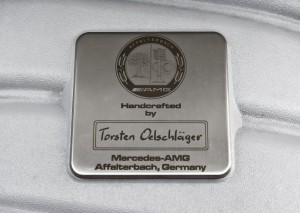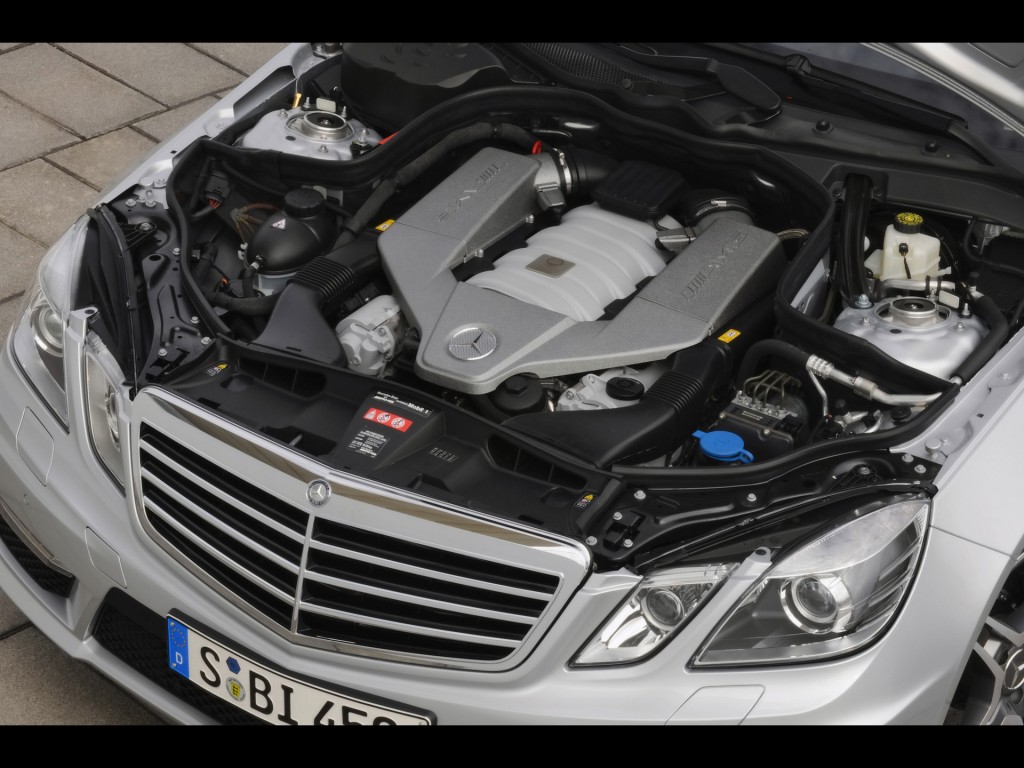Mercedes-AMG has a unique way of configuring AMG cars compared to other Mercedes vehicles. AMG cars utilize the “one man, one engine” approach to building the product. The AMG engines are constructed by a single engineer at the Affalterbach plant from start to finish. Proof of the one man approach can be viewed on the metal plate in every engine that holds that mechanic’s signature. The mechanics use a variety of workstations as part of an 11-step process in building the engine. Each workstation in the U-shaped work shop is utilized for a different job. Additionally through the use of a bar code system a computer daily evaluates the quality in order to ensure standards are being met. Each engine has a list of parts, instructions, processes, and different sequences that is kept in the computer system. Every detail of the workflow is tracked through the computer system. It can take on average three hours to produce a V8engine while the V12 engines can take a whole day. There are approximately 1,000 employees at the plant producing up to 20,000 high performance engines each year. (Vorano, 2011). Once the technician finishes assembling the engine the item is individually tested and moved to a storage facility (Reich, 2012).
Mercedes-AMG has seen tremendous growth in its sales in the last few years. The first quarter of 2012 showed more than a thirty percent growth in market share. “As the first vehicle developed independently by Mercedes-AMG, the SLS AMG super sports car unveiled in 2009 proves to impressive effect the competence and passion which exists at the headquarters in Affalterbach ((Mercedes-Benz: The AMG Story, 2012).’” Due to the increase in demand, AMG will focus on expanding their production. AMG will produce the 2.0-liter four-cylinder turbo engine at their production plan in Kolleda. This production will continue employing Mercedes “one man, one engine” approach. In addition Mercedes future growth strategy will enable production of several new models of vehicles in their high-performance category. “According to Ola Kallenius, Chairman of the Board of Management of Mercedes-AMG GmbH, ‘we have decided to expand our model range from its current level of 22 vehicles to around 30 vehicles in the future. We are looking to increase our global sales which today stand around 20,000 vehicles, to more than 30,000 vehicles by the time our 50th anniversary, and thereby assert our leading position in this exclusive segment (Mercedes-Benz: The AMG Story, 2012).’”
Mercedes “one man, one engine” approach has proven to be a successful operations management tactic to producing a vehicle. In addition to that, it shows the company’s appreciation for the workers by putting each craft man’s signature on each engine they produce. The large growth in sales and increase in demand is a reflection of this success. As a result, Mercedes plans to produce a large range of new high performance vehicles continuing their singular approach to vehicle production.
So, is the “One man, one engine” principle better than the assembly line approach?
here is a video that shows how the engines are assembled
Sources:
-Mercedes-Benz: The AMG Story, 6/20/2012.
http://luxvelocity.typepad.com/luxvelocity/2012/06/mercedes-benz-the-amg-story.html
-The one man, one engine method at AMG,4/7/2011
http://www.thenational.ae/lifestyle/motoring/the-one-man-one-engine-method-at-amg
-2012 Mercedes-Benz ML63 AMG –One Man, One Engine
http://focusdailynews.com/mercedesbenz-ml-amg-one-man-one-engine-p6291-84.htm


The worst thing about this is that it is almost false. My friend talked to a technician in AMG Germany and he said it is nothing but false, because technicians check the quality only and they don’t built anything anymore as they used to. There is a huge demand on AMG vehicles and it cannot be made handmade anymore. They continue doing it as to show their history and show that Mercedes is proud of this history. However, this method with “one man, one engine” works effectively.
Regardless of the validity of the claim, a job shop approach (which the original post outlines) has its merits, particularly when there is a high level of customization from order to order, or when the cost of building assembly line standards are too high (frequent product changeovers, unique requirements, etc.)
I would concur it seems unlikely that a major brand like MB would still be able to afford to employ the number of workers to build the volume of engines I imagine that are required.
It does but not to consumer but business man becuase now you can tell who is the technician that built that engine with recognition of his work out preforming other technicians. Like how people want rare cars now people would look for the technician signature on the engin and want to buy that one. Which is a good idea for both consumer and business wise ebcuase you can tell which technician is good or not and which car would be better than the others. Gives a better value to the car like an autograph.
I think that this is a good marketing strategy by Mercedes Benz. They are appealing to customers who are willing to pay more to distinguish themselves from other customers. I doubt that these cars are actually being completely hand built by these engineers, so it is a good way to add to the revenue they can gain from the product.
This was very interesting and the video was informative. I do think it would be very expensive to use the “one man, one engine” approach. I do like the quality testing and there importance on measuring accuracy in the engine. To answer your question, whether or not “the “One man, one engine” principle better than the assembly line approach?” It seems to me that this question would matter on variables that include cost and sales numbers…So Mercedes will have to determine that for themselves. I will say that the assembly line model is better for mass production.
Though the concept seems good, I do have few concerns about this methodology. It may seem like a very good marketing strategy, but one man can not be perfect in everything. Dividing labor into different fields creates specialization, which assigns everyone roles and give the forgetful mind of a human being an opportunity to become an expert certain part of a car’s production rather than burdening it to remember and performing the entire process of building a machine. for instance, a basketball team has assigned roles for everyone on the team, no individual is capable of playing point, center, forward and wing position. they are assigned to their roles and thats what they specialize in. Working on a project as a group will also help them save time, money(labor cost), and it will be less stressful for the employees.
I don’t believe it will make any difference to the consumer whether the car is build by one individual or a group of employees. What customer cares about is the price, performance and the outcome of the project.
I recently visited the BMW manufacturing plant in Munich as part of a spring study abroad trip. At BMW their process is almost completely automated with employees doing quality inspections or simple assembly of pieces. It was shocking how little the employees the actually did, yet there were so many working and with very little to do. Even though there were quality inspectors throughout the process, in the end it was a machine that did the overall quality inspection to check for human error. This is an interesting concept, but with the world moving so rapidly toward automation, I doubt it will last.
It seems as if Mercedes has taken customization as a business model to a whole new level with this vehicle. This production srategy will or does probably produce many loyal customers for them. On the other, internal control costs, customer service costs, and produce costs must be very high. A lot of careful planning, in regards to their product marketing and equipment investments, must have gone into this business strategy, if Mercedes aimed for the sustainability of the AMG’s production or operating activities.
The “one man, one engine” operations management tactic appears to be better than an assembly line approach for the AMG many reasons. Clearly, it is working in terms of revenue, as the article stated that sales have increased 30% recently. But this concept works in theory for two main reasons.
The most obvious reason is the marketing aspect, because people buying luxury goods like to know that a lot of care, experience and pride went into creating the product they are buying. Also, ensuring the ‘personal touch’ that went into building the engine by including a signed plate makes the product more unique than it already is. People spending a lot of money on a product also want it to be unique.